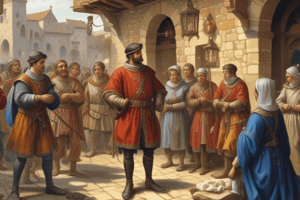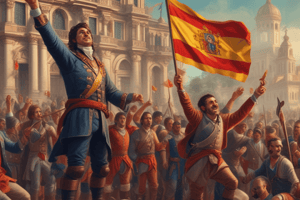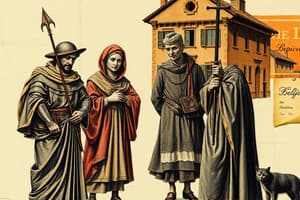Podcast
Questions and Answers
Which of the following best describes the primary goal of the Desamortizations regarding land ownership in Spain?
Which of the following best describes the primary goal of the Desamortizations regarding land ownership in Spain?
- Nationalizing all land and placing it under direct state control for collective farming.
- Preserving the traditional feudal land structures while modernizing agricultural techniques.
- Distributing land equally among all social classes, including peasants and the working class.
- Transitioning from feudal land ownership to a private, capitalist system. (correct)
Mendizábal's Desamortization of 1836 primarily targeted which type of property?
Mendizábal's Desamortization of 1836 primarily targeted which type of property?
- Properties of regular and secular clergy, including monasteries and convents. (correct)
- Land owned by the aristocracy and other wealthy landowners.
- Municipal lands and properties owned by military orders.
- Royal estates and properties directly controlled by the Spanish monarchy.
What was the main difference in target between the Desamortization led by Mendizábal in 1836 and the one led by Madoz in 1855?
What was the main difference in target between the Desamortization led by Mendizábal in 1836 and the one led by Madoz in 1855?
- Madoz targeted only the land owned by the aristocracy, whereas Mendizábal targeted land owned by the bourgeoisie.
- Mendizábal focused on urban properties, while Madoz focused on rural agricultural lands.
- Madoz aimed to redistribute land to the peasants, while Mendizábal only sold land to the highest bidders.
- Mendizábal targeted church properties, while Madoz included municipal land, military orders, and charitable institutions in addition to church property. (correct)
Which of the following was a significant economic consequence of the Desamortizations in Spain?
Which of the following was a significant economic consequence of the Desamortizations in Spain?
What was the social impact of the Desamortizations on the Spanish peasantry?
What was the social impact of the Desamortizations on the Spanish peasantry?
How did the Desamortizations affect Spain's national heritage?
How did the Desamortizations affect Spain's national heritage?
Which social classes were the primary beneficiaries of the Desamortizations?
Which social classes were the primary beneficiaries of the Desamortizations?
What form of compensation did the Church receive after losing its landed wealth due to the Desamortizations?
What form of compensation did the Church receive after losing its landed wealth due to the Desamortizations?
Which factor most significantly contributed to the slower population growth in 19th-century Spain compared to other industrialized Western European countries?
Which factor most significantly contributed to the slower population growth in 19th-century Spain compared to other industrialized Western European countries?
How did Desamortizaciones affect the traditional power structure in 19th-century Spain?
How did Desamortizaciones affect the traditional power structure in 19th-century Spain?
Which of the following best describes the primary ambition of the Spanish bourgeoisie in the 19th century?
Which of the following best describes the primary ambition of the Spanish bourgeoisie in the 19th century?
What was a significant consequence of the harsh working and living conditions experienced by the industrial workforce in 19th-century Spain?
What was a significant consequence of the harsh working and living conditions experienced by the industrial workforce in 19th-century Spain?
Which of the following factors most inhibited investment and increased production within the primary sector during 19th century Spain?
Which of the following factors most inhibited investment and increased production within the primary sector during 19th century Spain?
What role did women primarily play within the economic structure of 19th-century Spanish households across various social classes?
What role did women primarily play within the economic structure of 19th-century Spanish households across various social classes?
Which of the following statements accurately characterizes the economic evolution of Spain throughout the 19th century?
Which of the following statements accurately characterizes the economic evolution of Spain throughout the 19th century?
How did the economic challenges in the agricultural sector affect the social dynamics of 19th-century Spain?
How did the economic challenges in the agricultural sector affect the social dynamics of 19th-century Spain?
Flashcards
Population Increase
Population Increase
The Spanish population grew from 10 to 20 million during the 19th century.
Social Class Evolution
Social Class Evolution
Old regime classes transitioned into a capitalist class-based society.
Desamortizations
Desamortizations
The process that shifted land ownership from the Church and aristocracy to the bourgeoisie.
Bourgeoisie
Bourgeoisie
Signup and view all the flashcards
Lower Middle Class
Lower Middle Class
Signup and view all the flashcards
Rural Exodus
Rural Exodus
Signup and view all the flashcards
Labor Associations
Labor Associations
Signup and view all the flashcards
Economic Phases
Economic Phases
Signup and view all the flashcards
Goal of Desamortization
Goal of Desamortization
Signup and view all the flashcards
Desamortization of 1836
Desamortization of 1836
Signup and view all the flashcards
Desamortization of 1855
Desamortization of 1855
Signup and view all the flashcards
Impact on Land Ownership
Impact on Land Ownership
Signup and view all the flashcards
Beneficiaries of Desamortizations
Beneficiaries of Desamortizations
Signup and view all the flashcards
Effect on Church
Effect on Church
Signup and view all the flashcards
Peasants' Economic Situation
Peasants' Economic Situation
Signup and view all the flashcards
Study Notes
Population and Social Class in 19th Century Spain
- The Spanish population increased from 10 to 20 million inhabitants during the 19th century, a slower rate of growth than other industrialized Western European countries.
- Traditional social classes of the Old Regime evolved into a modern, capitalist class-based society.
- The aristocracy, despite losing feudal rights, gained economic power through Desamortizations and integrated into the ruling bourgeoisie group.
- The Church lost significant economic power and social influence due to the Desamortizations.
- The bourgeoisie, composed of industrialists, financiers, high-ranking military officers, and administrators, sought social equality with the aristocracy.
- Middle classes, composed of merchants, workshop owners, army officers, public employees, lawyers, and doctors, had social prominence in cities.
- The lower middle class consisted of shopkeepers and artisans working in small, minimally mechanized workshops.
- Peasant laborers, the largest population segment, mostly worked as day laborers. Harsh conditions led to numerous rural revolts.
- Industrial workforce, especially in Catalonia, grew rapidly because of rural exodus—former peasants and artisans seeking city jobs.
- Harsh factory and slum conditions heightened worker awareness, stimulating labor associations and early unions.
- Domestic service positions, primarily for women, were frequent in aristocratic, bourgeois, and middle-class households.
Economic Changes and Desamortizations
- The Spanish economy slowly changed during the 19th century, influenced by the Industrial Revolution and liberal economic models.
- Three economic phases defined the 19th century: decline (1800-1830), growth (1830-1875), and industrial growth (1875-1914).
- The primary sector, agriculture, faced significant challenges including five subsistence crises in the latter half of the 19th century.
- Traditional landownership, with the Church and rentier aristocracy dominant, hindered investment and production.
- Liberal reforms sought to modernize land ownership, driving the Desamortizations.
The Desamortizations
- Desamortizations were government-led land expropriations from the Church and other institutions, sold at public auction.
- The aim was to create more productive land ownership structures and fund economic/military needs.
- The 1836 Desamortización, by Mendizábal, targeted clergy, monasteries, convents, art, and books.
- This aimed to fund the Carlist Wars and reduce national debt.
- The 1855 Desamortización, by Madoz, further reformed land ownership, including municipal land, other church property, military orders, and charities.
Impact of the Desamortizations
- Desamortizations shifted land ownership from feudal to private capitalist structures.
- Although improving agriculture, land ownership remained concentrated.
- Public debt did not significantly decrease, but raised support for liberal causes among land buyers.
- Aristocracy and bourgeoisie were the primary beneficiaries, expanding their property holdings.
- Loss of national heritage: many artworks and valuable items were sold/dispersed during the Desamortizations.
- Church wealth decreased, compensated by government subsidies for clergy and education support.
- Peasant economic situations worsened due to loss of communal land, heightened day laborer numbers.
Studying That Suits You
Use AI to generate personalized quizzes and flashcards to suit your learning preferences.




